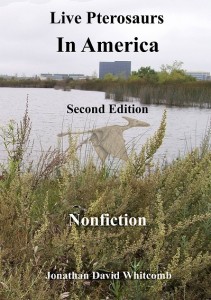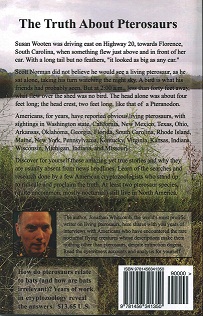Let’s consider two states where eyewitnesses report seeing living pterosaurs: Kansas and Arkansas. Both sightings are covered in detail in the book Live Pterosaurs in America, nonfiction cryptozoology.
“My friend and I were talking and I mentioned that I had seen an extremely large bird that resembled a pterodactyl some years ago . . . I could not believe my eyes as I immediately thought of a prehistoric bird when I saw it. . . . a wing-span of 16-20 feet.”
This eyewitness used the word “bird,” apparently thinking that pterodactyls are prehistoric birds. But when asked about the possibility of feathers, she said, “It did not appear to have feathers.”
Pterosaur in Arkansas
“It was probably 1982 when me and my older brother were sitting in our carport [in Texarkana, Arkansas] It was getting dark but there was plenty of light in the sky when we saw what we believe to be a pterodactyle [pterosaur]. The wingspan seemed to be about 25’ to 30’ ft wide. . . . an awesome sight to see.”
Question: Was there any sign of feathers or . . . was it leathery or naked skin?
Answer: We did not see any signs of feathers, just sharp edged wings, the sharp pointed beak, and the sharp pointed crest on its head.Question: Did it have any tail? [long-tailed flying cryptids are my specialty]
Answer: We did not see any tail. I have looked at my dinosaur book and the picture of the pteranodon looked like what we saw.
_____________________________________________________________________________
From readers of first edition of non-fiction book Live Pterosaurs in America (note 2nd ed.):
 “[The] new book arrived today! . . . a wonderful job!!! . . . more sightings than they can dispute (21 states!!!) . . . a descriptive and engaging ongoing investigation . . .” Susan Wooten, South Carolina.
“[The] new book arrived today! . . . a wonderful job!!! . . . more sightings than they can dispute (21 states!!!) . . . a descriptive and engaging ongoing investigation . . .” Susan Wooten, South Carolina.
“This seems to be the author’s second book on the subject, and this one is worth the effort. He has focused on the accounts of witnesses who saw something, and that adds credibility. The writing is easy to read and he adds comments and analysis . . . more useful. . . .” Red Rabbit, Cleveland, Ohio. [Five stars for the first edition]
“The problem with science is that we think we know it all and that is far from reality. This book shows courage to continue the search. If you have an interest in cryptozoology you should read this.” Dale Reeder, PA.
“This book is a great book! This book contains a lot of sightings and information on living pterosaurs. I highly recommend this book to anyone who is interested in living pterosaurs.” [from Amazon-anonymous child] A Kid’s Review [Five stars for the first edition]



